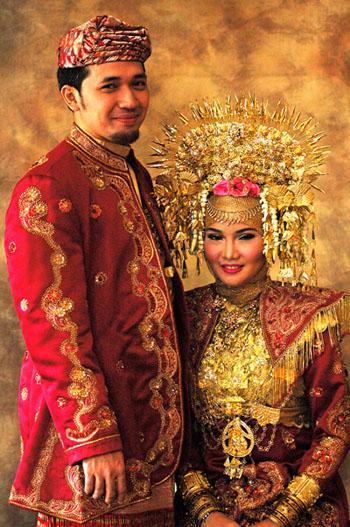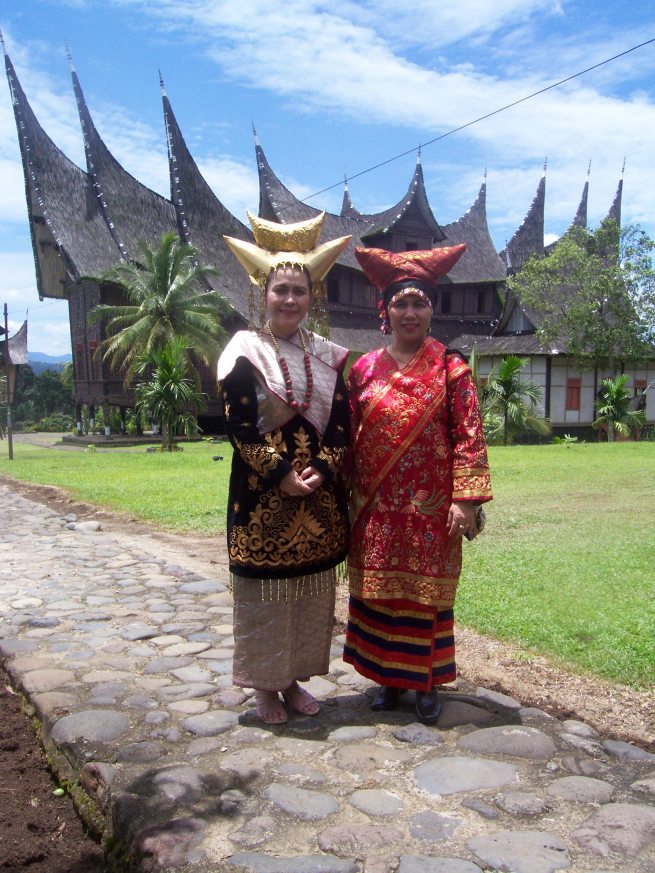
Again a most interesting morning at the MCG! This time we were fortunate to have our own member, Rose Gan, enthusiastically share with us her fascination for the Minangkabau. Before living in Malaysia, she spent four years in Indonesia where she was a museum guide besides being actively involved with the Indonesian Heritage Society. Her experiences have now made us richer.
The subject is so vast that I shall just try and mention the main points of Rose’s exposé. Let’s start with history. Officially, it is by early 15th century that a good number of Minangkabau people migrated to Neegri Sembilan from Sumatra attracted by the wealth and opportunities generated by Malacca. However, there are neolithic megalith sites in the State that hint at a much earlier arrival of settlers from Sumatra. They were mainly farmers but also brought along a whole range of traditional food (rendang, cili api...) as well as the art of songket weaving as this magnificent cloth, heavily woven with gold or silver threads, was the favourite apparel of the sultan, his entourage and the gentry. And this included also the Tangkuluak or traditional “horned” headgear of the women. By the way, the first king of Malaysia being from Negeri Sembilan, has his Minangkabau-style headgear featured on Malaysian banknotes, and this style of headgear has been worn by all the kings ever since.
Negeri Sembilan was founded in 1773 by Sultan Raja Melawar who came over from Sumatra. Today the succession to the throne is decided by the Council of four Undang (Chiefs) as the position is not hereditary. Upon the demise of the Yang Di-Pertuan Besar, these four persons will choose who among the royal family is most suited for the august position.
But what does “Minangkabau” mean? Apparently it means “victory of the buffalo” and history/legend has it that it refers to the victory of a small buffalo calf goaring to death the enemy’s huge war buffalo in a seemingly hopeless showdown.
The outstanding character of the Minangkabau is that they live in a matrilineal society, the largest in the world. A society where women have a say in all matters.
Rose underlined the big difference between a matrilineal and a matriarchal society. Minangkabau women nurture kinship, property, children, education, heritage items, maintaining an extraordinary balance with men who do not feel excluded but rather complement each other as they have their place in town councils. It is a society that is egalitarian and resourceful. One remarkable point is that upon marrying, the groom moves into the house of his bride bringing nothing along, because what he brings with him will automatically become his wife’s possession.

Rose then helped us discover the state of Minangkabau in West Sumatra, a territory that has always been open to change and accommodating. It stretches from the beautiful Pesisir Coast to the highland district of Darek in the interior with exhuberant nature and unpredictable volcanoes. It is here that one understands how close the people are to nature. Their customs and traditions, called “adat”, are steeped in a world of deep respect and understanding for nature. They are in fact called “the people of the adat”. An interesting concept is that of “merantau” or going away and this concerns young men not yet mature enough to integrate and comprehend fully the adat. They are encouraged to go as far as Jakarta or further, see the world, spend their hormone-laden energy and return once they are ready to integrate into their own society.
Apart from the magnificient songket, other textiles, brocades and silks are painstakingly woven into ancient motifs. We also admired the astounding architecture of the “Rumah Gadang”, the stilted family houses, with their upswept gables allowing for a cool interior and the exterior made up of colourful painted panels. They are traditionally built in wood and bamboo without any nails. We also learned how these houses are extended so that each daughter may live in a “wing” after they marry. Slightly apart from the main building, stands the rice barn. The mosques are also rich in design and carvings.
The morning ended with a look at a few traditional sayings, a fitting tribute to these multi talented and resourceful people who have found a way of upholding ancient traditions while embracing the modern world.
A big Thank You, Rose.
Written by Colette Hassan
